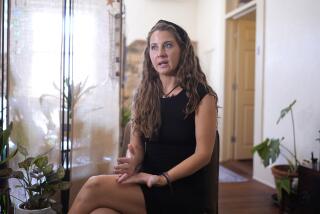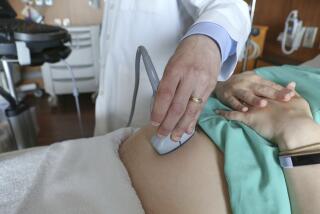Disabled mothers-to-be face indignity: ‘Do you have a man? Can you have sex?’

Disabled women now get pregnant and give birth at the same rate as nondisabled ones, but modern medicine has turned its back on them. L.A. Times reporter Sonja Sharp explores the topic of disabled pregnancy through her reporting and her lived experience. (Video By Jessica Q. Chen / Los Angeles Times) (Photos by Christina House / Los Angeles Times)
- Share via
It was just after 10 a.m. on a bustling, bleary-eyed morning at the AltaMed clinic in Pico Rivera, and Dr. Marie Flores was fighting to keep herself composed.
The waiting room was full. A line snaked out the front door into the parking lot. Flores raced between exam Room 26 and her office in a blur of cobalt-colored chrome and ultramarine fabric, her face glowing with effort and a high dose of estrogen.
“No no-shows today,” the doctor sighed, a portrait of the artist Frida Kahlo spying over her shoulder as she stashed the fertility drugs in her desk. “I was really hoping I would have some. I’m exhausted.”
The hormones marked Flores’ first step toward motherhood after a devastating miscarriage last fall. But they also marked a leap of faith in a medical system that desperately fails disabled women like her. While a physician in a wheelchair is the brochure image of modern diversity, a pregnant woman who uses one is as overlooked and ill-treated as Kahlo was when she turned up expecting at Henry Ford Hospital almost a century ago. (The artist had multiple disabilities from childhood polio and a debilitating accident as a teenager.)
Kahlo “also struggled to become a mom,” enduring loss after loss in her quest for a child, Flores said. “It makes me think, how many disabled women out there went through a similar experience? But we don’t hear their stories.”
There are no women like Flores in obstetric textbooks. They are not pictured on Pampers or Enfamil cartons, not counted in maternity statistics. Though disabled women now get pregnant and give birth at the same rate as nondisabled ones, most obstetricians know little more about them than Kahlo’s doctors in Detroit did in 1932. At every step, by virtually every measure, modern medicine has turned its back on these women.
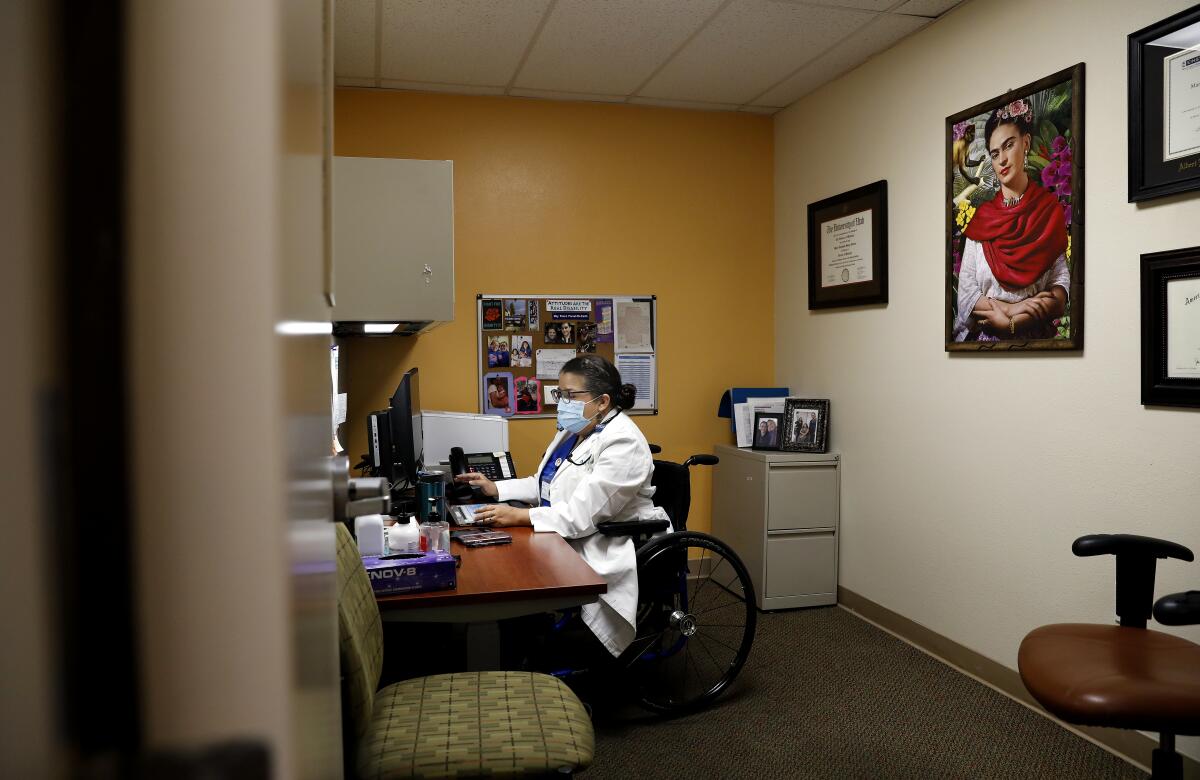
“I started looking at the literature, and it was virtually absent,” said Monika Mitra, a professor of disability policy at Brandeis University and principal investigator at the National Research Center for Parents with Disabilities. “I was really surprised at the lack of information and data.”
The National Council on Disabilities estimates there are at least 4.1 million disabled parents raising kids under 18, making them about 25% more common than disabled children, according to the U.S. census. In California, the cradle of the disability rights movement, thousands give birth every year.
Yet while disabled doctors, artists, athletes and politicians are increasingly seen as normal, disabled mothers are still scarcely imagined to exist.
“I work in the pregnancy and prenatal area, and every time I say this, people always assume it’s parents of children with disabilities — as if parents can only be able-bodied,” Mitra said. “The assumption is that a person cannot have a disability and take care of someone else.”
“Do you have a man?” “Are you in a relationship?” “Can you have sex?”
— Questions asked of Falayla Franck, a disabled mom
That assumption persists in part because it was legally enforced for most of the last century. Forced sterilization of disabled adults was still legal in 1979, four years after American public schools were required to integrate disabled children.
“I grew up in the Bay Area at the height of the disability rights movement — I can’t think of a category of disabled person I didn’t see pregnant,” said Rebecca Cokley, disability rights program officer at the Ford Foundation and a renowned disabled activist who has the most common form of dwarfism. “I didn’t realize for a long time how radical it was.”
People who grew up with the right to study, work and access public spaces are sometimes shocked by the stigma they face when they seek to have children. Even today, public health authorities keep detailed records on disabled women’s contraceptive use, and no records at all on what happens if and when those same women get pregnant.
The result, new research shows, is a cascade of harms that cannot be explained by medical complexity or anatomical difference. A blind woman is twice as likely as a sighted one to give birth by C-section. A wheelchair user like Flores, who has a genetic neuromuscular condition, will typically go her entire pregnancy without being weighed. Mothers with intellectual disabilities are half as likely to breastfeed, while those with physical disabilities are at significantly increased risk for postpartum depression.
Dozens of interviews with obstetricians, researchers, activists and disabled birth parents show how these statistics shape the reproductive lives of families across California.
“It’s the chicken and the egg,” said Dr. John Ozimek, a maternal fetal medicine specialist at Cedars-Sinai Medical Center. “We do see an increased rate of complications [in disabled patients], but it’s not a result of the disability; it’s a result of their not getting appropriate care. They’re not getting standard pregnancy treatment.”
::
Standard pregnancy treatment begins with the assumption that a patient can get pregnant, and quite possibly already is, which is why most women between 15 and 50 have been asked the same series of questions by almost every medical professional they’ve ever seen.
(Though transgender men and nonbinary people also get pregnant, the terms “women” and “mothers” dominate existing research, as well as gendered reproductive norms from which disabled women are specifically excluded.)
“Do you get your period every month?” Flores asked her new patient Karla Olguin, who had come in Tuesday morning complaining of breast pain.
Olguin did.
“But you’re not trying to get pregnant right now, right?” The doctor inched closer to the exam table with her size 5.5 sneaker.
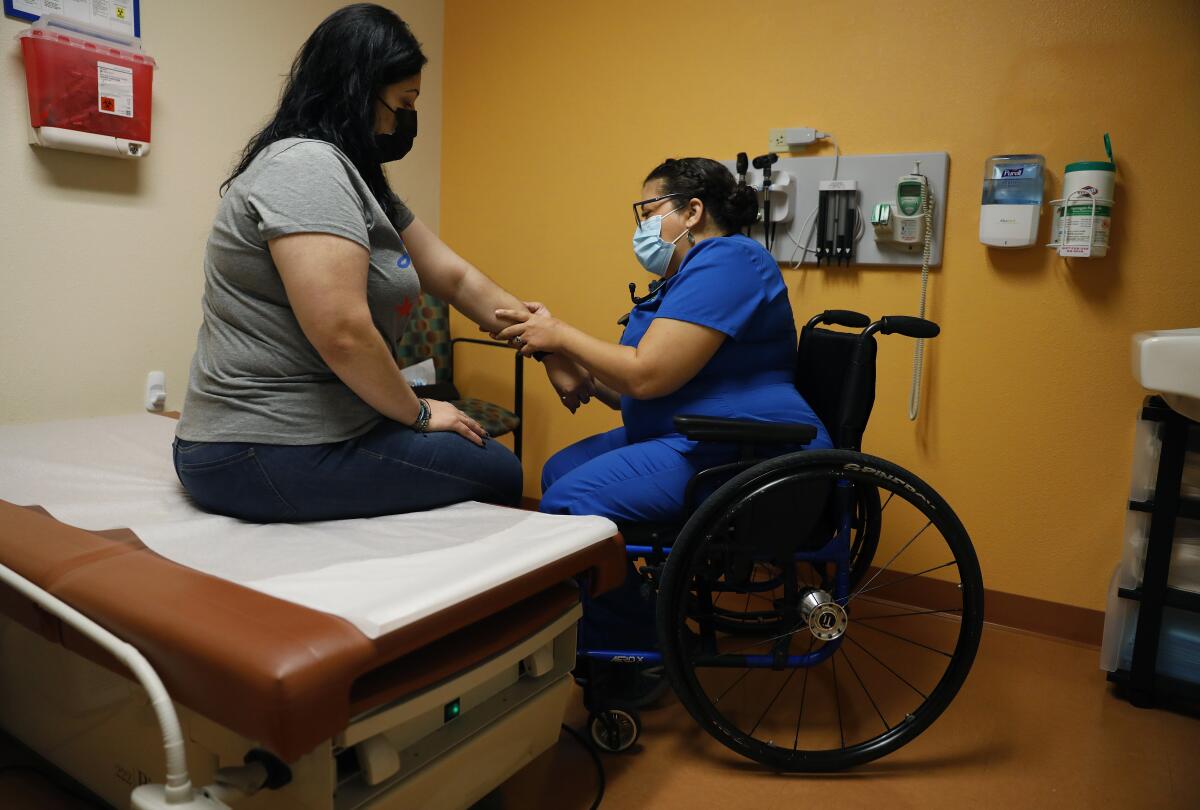
Olguin wasn’t. Still, surprise pregnancies are common in family medicine — not a week goes by that Flores doesn’t diagnose one. Books like “Contraceptive Technology and Management of Unintended and Abnormal Pregnancies” enjoy pride of place on her shelf at AltaMed, alongside Christmas photos of her dogs and her niece’s soccer portrait.
“About 50% of pregnancies in the U.S. are unintended,” Flores explained. “If [a patient has] diabetes, we want to check their sugar. If they’re young and female, we want to give them a pregnancy test.”
That’s because pregnancy is one of the most statistically normal biomedical events that someone with a uterus can experience. By their mid-40s, the overwhelming majority of women are mothers, and even more have been pregnant at some point in their lives. Treating or avoiding pregnancy is also one of the main reasons younger women see doctors, which is why ruling it out is so often a first step in a medical visit.
Yet for disabled women, that norm is often treated as aberrant.
“When people found out that we were trying, their response was, ‘Can you get pregnant?’” Flores said. “Like because you’re sitting in a wheelchair, you’re somehow asexual.”
Research shows disabled women are actually slightly more likely than nondisabled ones to get pregnant by accident. Yet the belief that they can’t — because they don’t have partners, or sex, or even reproductive anatomy — is fiendishly persistent.
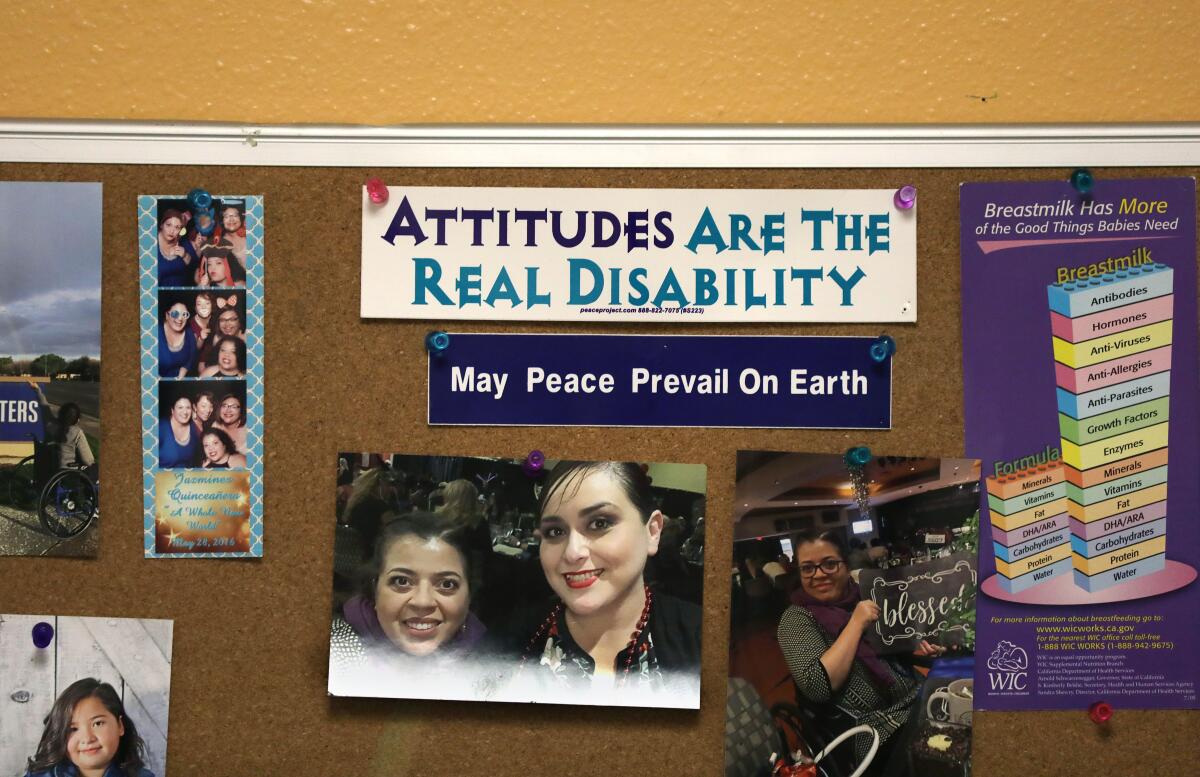
“People asked me that question: How did you get pregnant?” said Falayla Franck, a longtime friend of Flores’ and a fellow wheelchair user whose spine was damaged by a rare neurological illness in childhood. “‘Do you have a man?’ ‘Are you in a relationship?’ ‘Can you have sex?’ While I was pregnant!” The mother of twins laughed. “Well, yeah, I can. We have plenty of sex, actually.”
It’s not that strangers didn’t harass Franck before. But while most women experience street harassment as primarily sexual, those with visible disabilities are more often hounded by suspicion, curiosity, pity or disgust. For them, pregnancy offers a brief taste of normality.
“We get people coming up to us constantly, either trying to take our picture, or asking intrusive questions,” said Bay Area mom Elizabeth Campbell-Soper, who has achondroplasia, the most common form of dwarfism. “I was actually super excited to see how people would react to me being visibly pregnant and visibly disabled. [I] had sex and I’m able to create and sustain life — I yearned for people to look at me and make that realization.”
For Flores and many others, that perception is also tied to their gender identity.
“[For me] part of identifying as a woman is wanting to be a mother,” the doctor explained. “When people judge you and question your ability to do that, it’s very, very hurtful.”
It can also be very, very dangerous.
“Physicians who provide care to moms who have seizure disorders and things like that are commonly prescribing drugs that are not OK for the first trimester of pregnancy,” said Dr. Carla Janzen, a maternal fetal medicine specialist at UCLA. Doctors “use their go-to drug for the disease without thinking, this is a young woman who may become pregnant.”
Some of those medications can cause devastating fetal harm, often before most women know they’re expecting. Many more are believed to be dangerous, whether or not harm has been proved or is likely to be serious.
“They tell them not to get pregnant, or [to] get an abortion,” Janzen said. “We’ve seen a lot of moms who were told to abort and they really didn’t need to.”
At the same time, women whose medications are almost certainly safe are pulled off treatment in pregnancy, out of a “abundance of caution” for their babies.
“Many of these medications have never been shown to have any adverse effect on the fetus — you’re reacting to a theoretical risk,” said Ozimek of Cedars-Sinai. “We often have to reassure other specialties... if we hold the medication and the mother gets worse, that also affects the fetus.”
In addition to mothers with epilepsy, this practice also affects patients with autoimmune conditions such as lupus, multiple sclerosis and rheumatoid arthritis — diseases almost exclusively diagnosed in reproductive-age women. Mothers with one of these four conditions alone account for close to 1% of all births in L.A. County, making them roughly as common as mothers of twins.
Yet finding an obstetrician who will agree to take care of them is often exponentially more complicated.
::
“I always say the same thing: Have your doctor call me.”
This is Dr. Deborah Krakow, head of obstetrics and gynecology at UCLA and one of the most sought-after and trusted providers for women with disabilities.
“I cannot tell you how many obstetricians all over the country I’ve talked to, who, once you talk to them, really do want to take care of these patients,” the doctor went on. “I think they’re fearful. If you’ve never encountered that complexity, you’re worried you’ll get a very bad outcome. So you just say, ‘no-no-no, this is a bad idea.’”
Provider fear is just one of several barriers that disrupt and delay maternity care for disabled women. Medical racism shapes care for many, because a disproportionate number of younger disabled women are Black and Indigenous. Geography and insurance coverage also play a significant role in disabled parents’ care.
That’s because disability is concentrated in poor neighborhoods, while obstetricians with the expertise and training to treat disabled women are concentrated in rich ones. Of these, relatively few take public insurance, which covers half of all births in California, as well as about a third of working age women with disabilities.
“A lot of the women I interviewed were on Medicaid, and Medicaid pays lower rates,” said Dr. Lisa Iezzoni, a professor at Harvard Medical School who studies disability and pregnancy. “Sometimes they would have gone to seven or eight or nine doctors to try to find someone to agree to deliver their baby.”
The result is that disabled women search longer and travel much farther for care. They are also required to be seen more often, and by physicians in more specialties.
“It’s one of the most frustrating parts of practicing medicine,” Ozimek said. “You know what somebody needs and you know the best person to send them to, and you can’t get insurance to pay for it.”
Yet even for women with private insurance, finding competent care can be harrowing.
During her first pregnancy, Cokley was left in stirrups for hours because no one knew how to find the cervix of a person with achondroplasia. Flores had to travel 200 miles each way for obstetric care when she was pregnant last year, despite providing it almost daily to other women in the Central Valley, where she worked at the time. And Campbell-Soper couldn’t get care at all for the first 11 weeks of her pregnancy, delaying basic health screens as well as disability-specific tests that would tell her whether her son would survive long enough to come home from the hospital.
“We waited a long time,” Campbell-Soper said. “It was awful.”
Such prenatal testing has become dramatically more sophisticated in recent years. But it has also become more fraught. Obstetricians who fail to screen for disabling conditions can be sued for “wrongful birth” by parents whose children are born with disabilities such as sickle cell anemia, Down’s syndrome and spina bifida. (Meanwhile, scores of Californians with spina bifida give birth to children every year.)
“We always say, do you want a boy or a girl, and if you don’t want to answer, you say, ‘I just want them to be healthy,’” said Cokley, the disability advocate. “But for nondisabled people, ‘healthy’ means nondisabled.”
Yet most disabled parents feel quite differently. Some, like Franck, say their own experiences make them less frightened and better equipped to raise a disabled child. Others, including many with heritable conditions such as deafness and dwarfism, long to have children who share their features and their experience of the world.
“We were really excited at the possibility of [our son] also having dwarfism,” said Campbell-Soper, whose husband also has achondroplasia. “When we found out he did have it, I was over the moon.”
At the same time, she and others said they felt judged for having children who might need accommodations to attend school or work, or require ongoing medical care.
“As disabled parents, we’re held to a different standard,” she said. “If two nondisabled parents have a child who may be medically complicated, the onus is not on the parents. But when disabled parents have a medically complicated child, that’s where we get into the conversation about eugenics.”
Even Flores, who decided to screen out embryos with her condition when she and her husband began IVF, bristled at the implication that she should have to, or that she was selfish for wanting an experience that close to 90% of American women will have in their lifetimes.
“Why can’t I want to be pregnant? Why can’t I want to go through labor and breastfeed my child?” the doctor said. “I had a lot of people question, ‘Are you going to be able to push the baby out?’ Well, I don’t know! But the way they ask you, it’s as though you’re not as much of a woman.”
::
“Do you think that doctors say this to all pregnant women?”
This was the postscript Kahlo wrote to her personal physician and confidant Dr. Leo Eloesser in May 1932, after a doctor in Detroit told her she could safely continue her pregnancy and “have a child by Cesarean.”
Little is the same about obstetrics today as it was during the Great Depression. Yet caesarean birth remains the unquestioned standard of care for disabled women, whether or not it is medically indicated.
This reality stands in stark contrast to both medical and social attitudes about the procedure. California has made a concerted effort to reduce its rate of C-sections, yet almost a quarter of uncomplicated first-time pregnancies are still delivered by caesarean. Still, books, classes and other resources aimed at nondisabled women lead few to imagine that they will be among the 1 in 4. By contrast, disabled women consistently tell researchers that decisions about how they will deliver are made without their input, while large quantitative studies show they are disproportionately scheduled for surgical births with no clear medical reason.
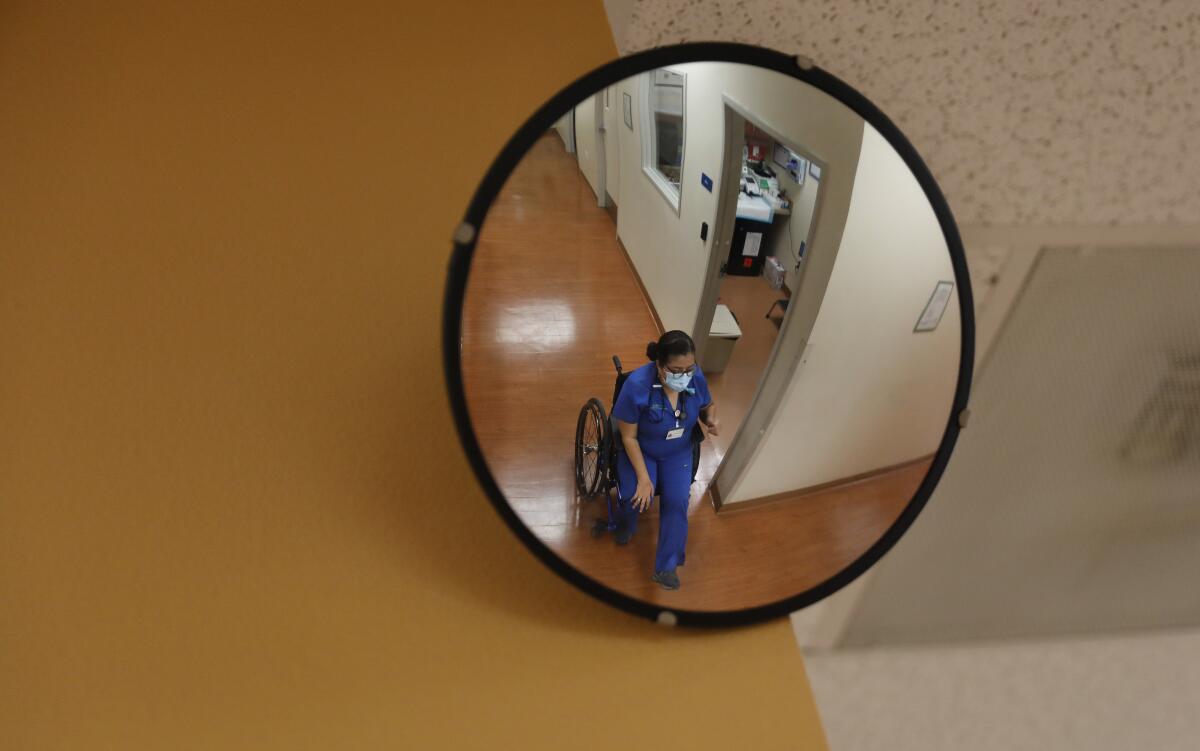
“No one ever asked me if I wanted a vaginal delivery — that’s something that I had to advocate for,” Flores said. “When Dr. Krakow said we could do a trial of labor … that alone just made me feel equal, not inferior to other women.”
Women with physical disabilities such as Flores may actually experience more caesarean complications than nondisabled women, because they are more prone to infections and poor reactions to anesthesia, more likely to have prior abdominal operations, and less able to perform the tasks necessary to recover from surgery or adapt to the resulting loss of function.
Yet, “the reflexive thing to do is deliver by C-section,” said Janzen of UCLA. “A lot of times in the community, doctors will do a C-section very prematurely, whereas at UCLA we really agonize over the data to see if we can provide a vaginal birth.”
C-sections are still sometimes necessary and remain the only safe way for parents with certain disabling conditions to deliver. Yet even those who know they will need a surgical delivery, and who take care to plan them, often say the experience was made more difficult, traumatic or dehumanizing because of their doctors’ attitudes toward their disabilities.
For Franck, the mother of twins, surgery took an unexpected turn when she was already on the operating table.
“They told me they were gonna do a little bikini cut [through a previous surgical scar] and then it was, “Oh, no, just kidding,’” she said. “They just gutted me like a fish.”
Her epidural failed, and so her torso-long incision was quickly stapled shut instead of stitched. When the staples broke loose, her abdomen was stuffed and bound, leaving her unable to visit her newborns in the NICU or even bathe herself. Not once was she offered a breast pump, nor any other way to connect with her children.
“At least I would have liked to have pumped, even if they didn’t give it to them, so I could have been successful later on,” she told Flores over lunch on a sweltering day in July. “They were like, well, you have to ask.’”
The doctor was gobsmacked.
“That’s the one connection they could have given her to help with the sadness she was feeling after having the babies ripped out of her, and they took that away from her, too,” Flores said.
Even C-sections that go more to plan can be traumatizing.
“I had this huge fear of being sterilized,” said Campbell-Soper, whose son Declan was born by planned caesarean in January. “I was so scared, I told the surgeon not to take my uterus out of my body. I was so sure something would go wrong and I would be sterilized.”
Such fears are not innate to caesarean sections. Yet the widespread belief that surgical birth is inherently unwanted and inferior, reinforced in most birth books and parroted by celebrities, leaves little space for mothers who could not have had children otherwise.
“A lot of moms feel their scar is a reminder of something that went wrong — but I wanted a C-section and I love my scar,” Campbell-Soper said. “My scar is a reminder that I carried him for as long as I did, longer than the doctors wanted me to. My scar is a reminder that I made it, and that he made it. It’s a reminder that I made life. It’s not painful at all.”
::
Given the existing research, it’s tempting to draw a grim portrait of disabled motherhood in the U.S. But like the bright Tehuana dresses Kahlo wore to hide her polio-shortened leg and orthopedic corsets, the data can obscure as much as they reveal.
The research would not exist at all if not for the National Institutes of Health, which started funding it when disabled women started getting pregnant in statistically significant numbers. For women with spina bifida and cerebral palsy, that’s because they live longer. For those with MS and lupus, it’s a function of better treatment and care. And almost all disabled people who get pregnant today grew up with the Americans With Disabilities Act, which has afforded them more legal, physical, and economic autonomy than in any previous generation.
What’s more, the research consistently shows that disabled women want children just as much as nondisabled ones do and are willing to fight much harder to have them, despite public erasure, medical ignorance and overwhelming social stigma.
“I get a lot of stares with my kids — I don’t know if I get it because of the wheelchair or because we’re a mixed-race family,” said Franck, who is Black. “I worry about that, because I know people with disabilities are more likely to have their kids taken away. Everyone who knows me would attest that I’m a wonderful mother, but what if I send them to school and they’re a little bit dirty?”
Indeed, disabled parents still disproportionately lose custody of their children.
“The phone calls I would get were heartbreaking,” Cokley said of her time running the National Council on Disability. “At that point I was pregnant with my second kid. What we learned was that in over 20 states you can lose custody solely on the basis of a disability diagnosis,” including at least half a dozen where physical disability alone remains sufficient cause for termination of parental rights.
Still, many said even a difficult pregnancy and childbirth felt profoundly healing after a lifetime of being told their bodies were wrong. Others said motherhood marked the first time they’d been perceived as “normal,” in an identity they’d chosen for themselves.
“I’ve had a couple of really sweet experiences of younger children looking at me and going, ‘Oh, she’s a mommy,’” Campbell-Soper said. “‘It was really nice to just be seen as that. It was a very pure feeling, because that’s all that mattered to them.”
For Flores, motherhood remains at the unfinished center of her complex self-portrait.
“I have accomplished a lot of things, but this was like, wow,” the doctor said of her pregnancy last year. “It gave me so much joy and pride to say it out loud to all the people in the world who thought I couldn’t do it. It felt so good to be like, ‘You were wrong.’”
Sharp, a Times staff writer who covers education and disability rights, produced this article with the support of the USC Annenberg Center for Health Journalism’s 2021 California Fellowship.
More to Read
Sign up for Essential California
The most important California stories and recommendations in your inbox every morning.
You may occasionally receive promotional content from the Los Angeles Times.

